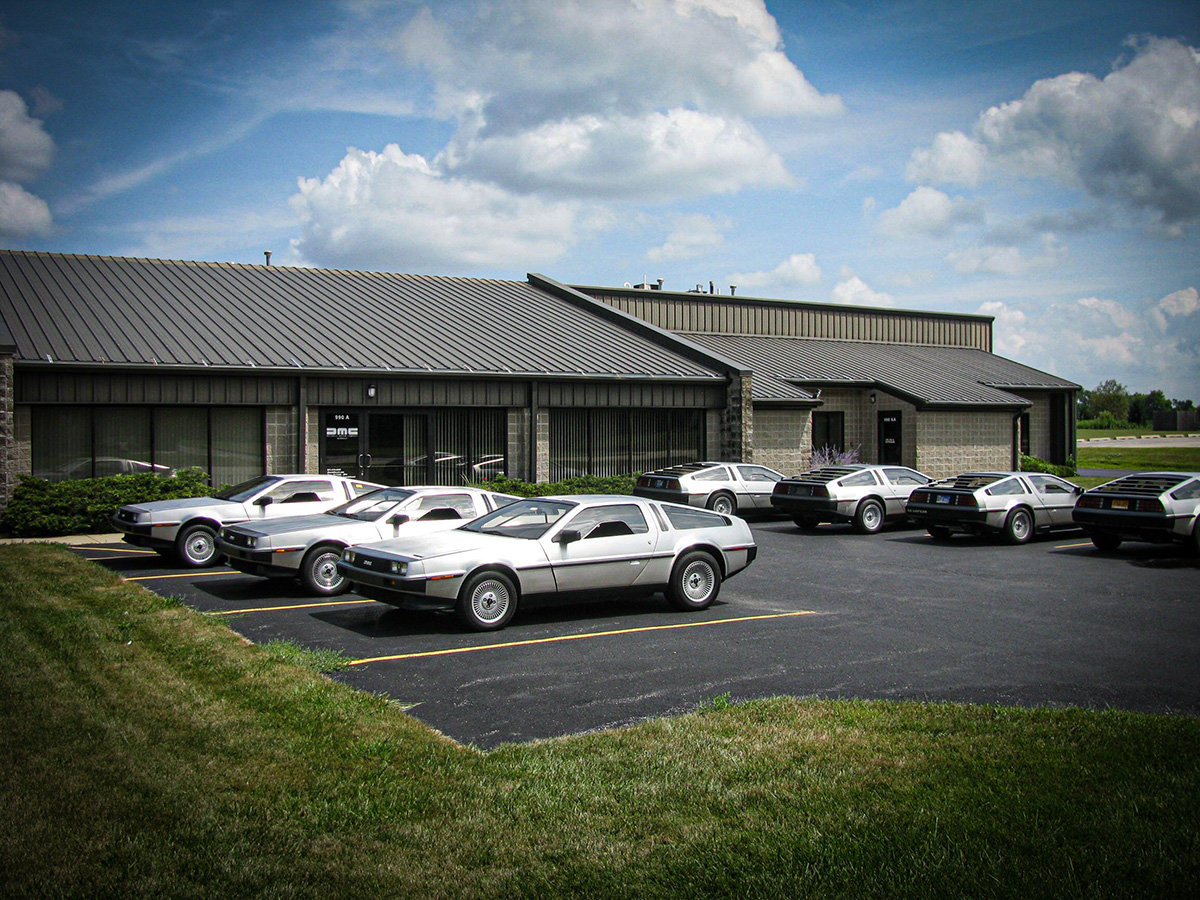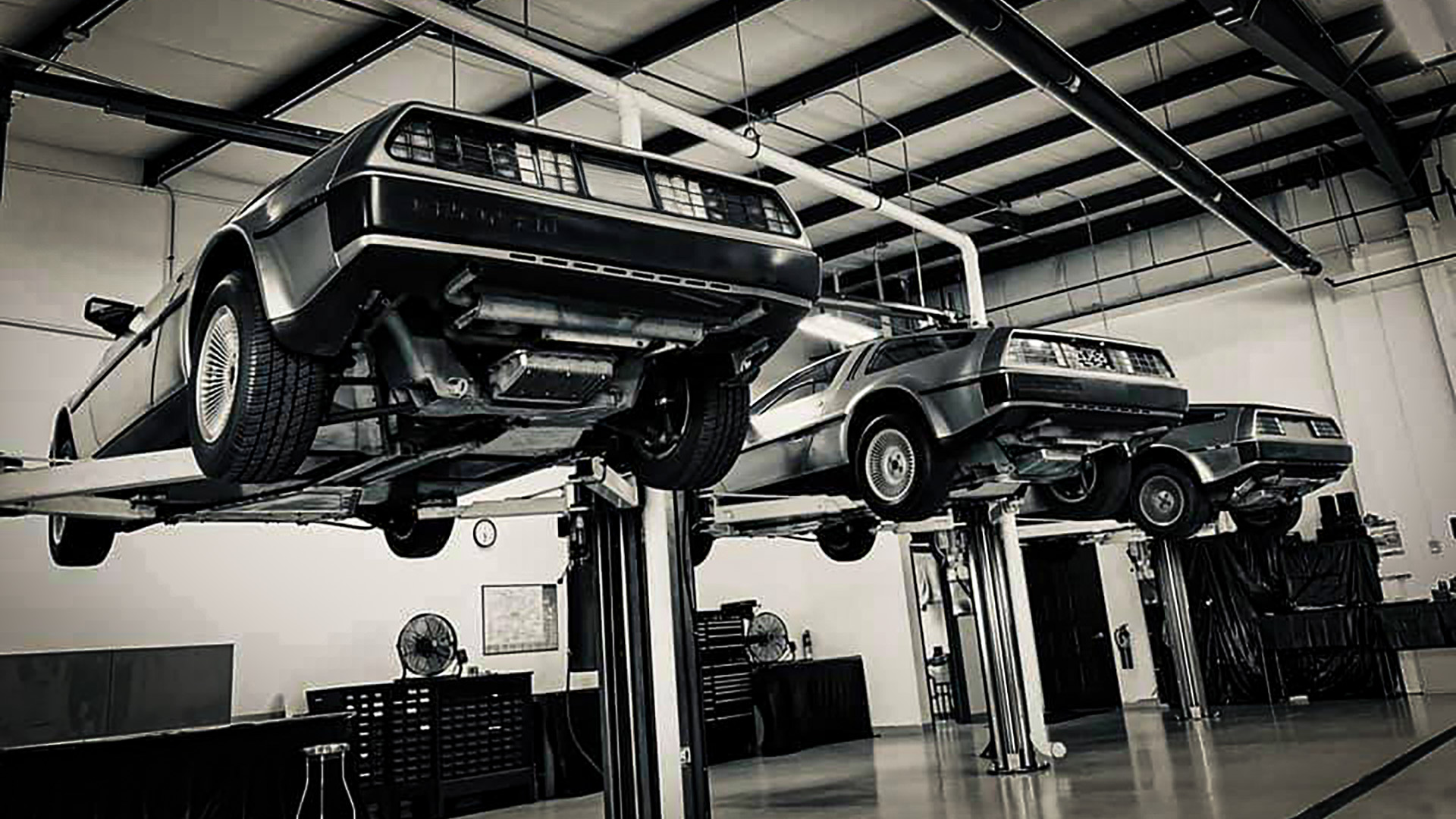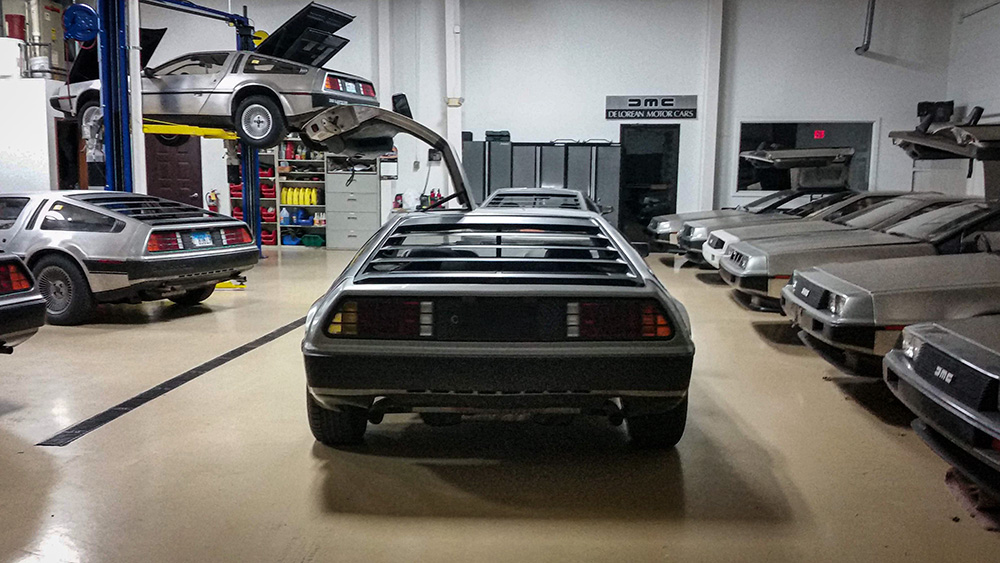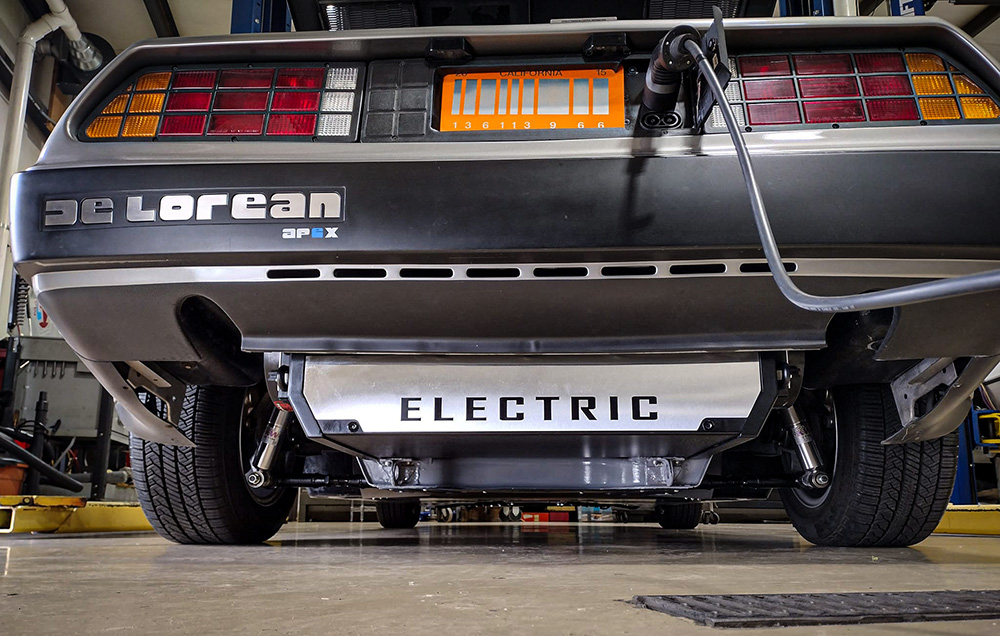Using your shop’s Cost of Doing Business (CODB) as a baseline for labor rates.

As a Gen Xer, I have a soft spot for the “Back to the Future” movies and, of course, the DMC DeLorean used in those movies. Then I learned of DeLorean Midwest, a shop based outside Chicago that specializes in—you guessed it—DeLoreans. Watch this video profile of DeLorean Midwest from WGN Chicago:
A shop that offers services, sales, parts, and restorations—but only for DeLoreans? I had to know more. Thankfully, I wound up chatting with shop co-owner Michael McElhattan and the interview was so intriguing to me that I knew I had to share it with you Shop Press readers. Michael is very knowledgeable and loves to talk about DeLoreans. Here’s the ins and outs of his shop in his own words; he does a far better job of conveying the passion that runs through his business than I ever could. Please enjoy our conversation!
Mike McElhattan, Co-owner, DeLorean Midwest: How I started on this was I responded to an ad in the paper where a guy was looking for a DeLorean technician. And my brother actually owned a DeLorean, so I was somewhat familiar with them. I responded to that ad and wound up being the first guy that was hired by the husband-and-wife team of Dave and Julee Swingle. I worked for them for nine years as their lead tech and then eventually shop manager. Then they retired in 2016 and sold the business to myself and my wife, Susie.
MM: We started wrenching on our first cars in early 2007. So, it’s been darn close to 18 years now.
MM: There is a decent amount in the Chicago area, but the majority of our work comes from out of state. We’re definitely the only specialized shop in the Midwest, and we pull cars from pretty much anywhere in the country.

Outside the DeLorean Midwest shop. Photo: DeLorean Midwest.
MM: Probably one of the bigger challenges on these is the fuel system. It’s a Bosch K-Jetronic. It’s similar to what they were using in Europe at the time, but it’s not similar to anything that was really done by the big three domestically. The fuel system is kind of obscure and the parts support on this 40-plus-year-old fuel system is getting harder and harder to source. That’s probably one of the biggest enduring challenges. Many cars have been parked for a good period of time. And when you park for that long, the fuel system obviously turns to gummy gasoline.
Now that they’re using ethanol in them, that’s a challenge because that can turn sticky and start affecting how the car runs within a couple of years. Bosch is a mechanical fuel injection that has moving parts inside of the fuel system with tight tolerances, and it does not perform well with sticky ethanol gasoline at all.
And then I’d say that the curse of working on them is when you’re working on the same car over and over, you know how well a job could go or should go and how terrible they can go. The main factor there is probably rust. If you have a clean one, that job goes real smoothly. But you may have a rusty one, that goes terribly. Then throw into the mix that somebody who didn’t know what they were doing put wrong parts on or something like that. That’s probably the biggest challenge, when you know this is a two-hour job but you’re six hours into it because of the condition of the car.
MM: Yeah. The parts availability on the car is actually pretty excellent. I’d say about 70% is still available as new old stock parts. They had planned to build a lot more cars than ever got built and back in the ‘80s they had a huge warehouse supplying the assembly line. Luckily, that huge warehouse is still around, so the parts supply is pretty fantastic. And it helps keep the cost of the repairs down because parts are relatively affordable.

MM: Oh man, I guess the best way I would answer that is I think that the DeLorean is probably the most iconic ‘80s car of all time. The prototypes came out in the late ‘70s and it got a lot of buzz, and it was the most highly anticipated car at that time. I have a poster on my wall from the ‘80s before the car was released and it says, “DeLorean: presenting America’s most talked-about car.” And all the articles that were written on this car. It was probably one of the most highly anticipated cars. Before it came out it was just all over the press.
John DeLorean was, to some, the godfather of the muscle car and people loved what he was doing. He was a very popular engineer and an executive at General Motors, and people were eager to see what he was going to come out with. And the fact that the car had a stainless steel exterior and gull wing doors—either one of those would have made a huge splash. And with both of those things, the car was really anticipated.
MM: He was. He was a weird combination of an extroverted engineer and an executive. He hung around with the Hollywood types, and you don’t see that nowadays. No GM executives today are hanging out with celebrities. But that was John. He was a very extroverted engineer, which is kind of a weird combination, personality-wise, but a very charismatic guy. He was the type of guy that you wanted to follow, and he was able to put a team of young people together and do something special.
This car is such an ‘80s icon. The car was highly anticipated before it ever came out. In the late ‘70s the first prototype was made, then the car was released in 1981, and it made a huge splash. They were selling for well over the asking price. People were really eager to get one.
Then there’s the whole John DeLorean drug bust, which adds kind of a OJ Simpson spin on the thing. After that, unfortunately the car factory shut down. That drug trial ran from basically 1983 and 1984. About the time that wraps up, the first “Back to the Future” movie comes out in 1985, and then there’s the subsequent movies in 1989 and 1991. And so, the car was just in the news and in pop culture through the entire decade. There are other really stylish ‘80s cars with unique builds, but I don’t think they held the spotlight for the entire decade like the DeLorean did.

MM: I’ve been talking lately as they age about the big four catastrophic failures with the car. I used to say there were three cardinal sins, and now there’s a fourth. And I would say number one is the frame. The frame is a mild gauge steel that’s epoxy coated. The panels are extremely resistant to rust, and you will not see that usually on a car. But the frame is a different story. If they’ve ever been driven in the salt or kept in damp storage for a long period of time, the deterioration of the frame can be a serious problem. It is a thin gauge frame. This was engineered by Lotus for them, so they were always about trying to shave weight in order to not need as much power and be a nimble car. It’s a very light car, but the thin nature of the metal means rust can be a serious problem pretty quickly if there is rot on the car. So that’s probably number one.
Number two is probably a seized engine. If the car is parked so long or parked in a damp environment, the engine can be seized. If the engine is seized, it’s pretty costly and difficult to locate engines. We actually do have new crate engines that are available, but they’re quite costly and they’re really going to run the cost of ownership up if your engine seizes and you have to go that route.
I’d say number three is probably what we call a roof cage. The cockpit of the car that extends into the trunk and engine area is fiberglass. There’s glass that sits over the steel frame and then the sheet metal is bolted to that. And then the roof structure—because the hinges at the doors are there and the torsion bars and struts that open the doors—they had to have the steel structure, to reinforce the fiberglass in the roof. It can be very different with cars that are salted. You see this more with cars that are parked outside in tropical climates or certain areas where it rains often, that roof gets wet and never dries out. And so that roof cage can rot out on them and that’s a pretty costly repair.
And then I would say the fourth is the stainless steel. It’s very resistant to rust, but the body panels will pit and rust if they’re neglected for a long period of time. If they’re left outside, you get bird droppings or leaf decay that’s accumulated on the car. Or the other scenario is that the car is parked inside but just not washed for a very long time, a decade or more, to where the dust can start to cause moisture buildup and then leads to rust and deterioration of the panels, which is irreversible. If it gets bad enough you cannot fix it. Luckily, we have panel replacements, and so that’s an option, but if you’re replacing panels all over the car that gets extremely costly.

MM: The last couple of years we’ve been focusing on that a lot. We’ve been at this so long we didn’t used to have such an interest in modifying and improving the cars and we do now. Our shop is specialized in doing engine swaps and transplants if customers are interested. It really is a small part of our business. To give you an idea, we see about 80 cars in a year for service. Compared to a regular shop, we just see way less volume and way more work gets done to each car. That’s how we make it work.
Last year, we did three LS swaps where we put Chevy V-8s in cars and probably fixed the most common complaint people have about the cars that they were not powerful. I think they were par for the course for 1981. It’s just that 1981 was probably the lowest horsepower year for Corvette and muscle cars, and horsepower was choked to death at that time. So, it basically triples the wheel horsepower from about 100 to about 300, even when we’re going with a very base, mild, stock-type setup on a Chevy V8. This past year, we’ve already completed two Tesla swaps, where we put a Tesla Model 3 drive unit in the car and all new battery packs and controllers. Everything’s new except for the drive unit. We just completed the second one. It’s functional and moving. We hope to have a third wrapping up right about the end of the year. A fourth actually just dropped yesterday that we’ll start the process on and probably finish that early 2025.
We’ve also done brake upgrades. The brakes were four-wheel discs, but they were solid unvented rotors in the front which is terrible for brake fade. You get about one 70-mile-an-hour hard stop before you start experiencing brake fade on these things. They just felt like they were a little underpowered in the braking. So, we have an upgrade for the front that makes a noticeable improvement and goes along well with the engine upgrades and drivetrain upgrades.
MM: We do. I’ve had as many as three “Back to the Future” tribute cars in my shop at one given time. To give you an idea, I think our high water mark was 35 DeLoreans under one roof at a time. Typically, we have 25 to 30 DeLoreans at any given time. Anything above 30, it gets really tight in here. But yeah, we have seen “Back to the Future” tribute cars. I’ve been a part of multiple tribute car builds, but we don’t do the props here.
MM: I do, yeah. We see buyers that are really interested in the car in their 20s. 25 to 45 is probably the age of most of our buyers. 25 to 55 maybe. So, I still think there’s a lot of those younger—35 and under guys especially—that are still interested in the car and will hope to obtain one. Values on all classic cars took a jump with COVID and so it’s out of the reach for some of those guys. Also, for a car from ‘81 to ‘83, the values are pretty significant. There are very few cars that are worth more that were production vehicles from that era. I’d say a nice one is probably sitting in the $70,000s right now for a DeLorean. A Corvette from that era is probably in the $20,000s for a nice one. They’ve held their value very well and just in the last five years we’ve seen a significant increase in value. I would expect it’s probably going to hold where it is.
MM: To be honest with you, we’ve had as much as a one-year backlog and are limited in the amount of work we can take on. Currently we’re at about a five- to six-month waiting list. In the past, it’s been much longer than that. So, to answer your question about taking on another brand: no, I don’t plan to.
I probably see us growing in the direction of offering more for the DeLorean. We actually just recently began offering a different wheel setup. The original wheels were fourteens in the front, fifteens in the rear. We’re going to offer sixteens in the front, seventeens in the rear. They still look the part of the vintage car, but it gives it a more low-profile tire. It gives you much more tire selection. Now we really only have one tire selection for tread pattern and brand of tire that fits the front and the rear, being that there’s not very many fourteens that people are selling. It’s kind of funny. At the time it was a 60 series profile which was considered a low-profile tire. But by today’s standards, it’s not. Truck tires are lower profile than that now.
We plan to continue to pursue improvements on the car and that’s where I see things growing. It’s kind of funny to say that we’ve gotten quite a bit busier in the last five years, I would say, than we’ve ever been. Which is a funny thing to say, because they obviously have not produced any new DeLoreans, so the amount of inventory has not risen. But I do think the interest has gone way up. The prices have gone way up. A lot of the cars that have been sitting in a barn for 20 years have been found and put back on the road. None of the shops are making any money on a car that’s sitting in a barn. But as soon as it’s pulled out and put back on the road, it’s possible revenue for a shop with parts or repair.
The new buyers really want to drive them, so that’s good for us as well. They want to get them out there; they want to enjoy the cars. They want to upgrade the cars. With so many more on the road that have been discovered and running again—with the values going up—it’s easier for people to justify putting money into a car when they’re at a pretty decent value. Now there’s this big push for upgrades that didn’t exist even five years ago. There’s a whole new realm of opportunities for the car, which is resulting in building a backlog for us. It’s just an oddity considering there’s no new product getting built but, even without that happening, we’ve been getting busier over time.
We’ve also established a reputation. When I started this 18 years ago, the cars were more like 25 years old and the guy up the street was willing to work on a car that was 25 years old. Now the cars are 43 years old and starting to deteriorate. Rust has gotten to them. They’re a little more difficult to work on. The guys who know how to work on cars from the ‘80s are retiring. So, the local shop is much less likely to say yes to a DeLorean and owner is much more likely to want a specialist.
The articles and other content contained on this site may contain links to third party websites. By clicking them, you consent to Dorman’s Website Use Agreement.
Participation in this forum is subject to Dorman’s Website Terms & Conditions. Please read our Comment Policy before commenting.